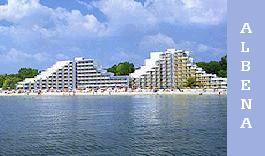|

Nessebar
- map |
Nessebar -
map
Known as Messembria by
its founders, Dorian Greeks, Nessebar was founded in the 6th century BC.
Today, the narrow peninsula (an island in antiquity, it was later
connected by a causeway) is one of Bulgaria's most delightful tourist
spots. Designated a UNESCO World Cultural Heritage Sight in 1983, the tiny
town attracts nearly a million yearly visitors. Narrow cobblestone streets
wind amongst quaint 19th century wooden houses, their tiny courtyards
filled with smokini (fig) trees and vine trellises. Although once graced
by forty churches, Nessebar's dozen remaining medieval churches are the
remnants of both Slav and Greek Orthodox communities that thrived here
during the middle ages.Old Town of Nessebar
Photo gallery( click on the image to
see its full size )
more info here
|
Sunny Beach ( Slanchev Bryag )-
Located just a mile north of Nessebar. Sunny Beach lives up to its motto of
"Where families come first." Children and toddlers are kept occupied with
the likes of kiddie trains, well-equipped playgrounds, and organized
festivals. But not only kids have all the fun. Adult sports include
windsurfing, sailing, parasailing, speedboating, scooter-driven
parachuting, pedalboating, waterskiing, horseback riding, archery,
mini-golf, roller and in-line skating, bowling, tennis, bicycling, beach
volleyball, and wall climbing (for the truly bored). To soothe sore
muscles after all that physical exertion there are balneo-therapy
treatment centers.
more
usefull info here
|
 |
Sozopol
interactive map
Sozopol
is a national and international holiday center attracting tourists from
Great Britain, Germany, Poland, Russia, Ukraine, Czech Republic, France.
The artistic atmosphere makes it the most favorite tourist
destination. Another opportunity for visitors in Sozopol is to be part of
the greatest Bulgarian cultural event - Apollonia Festival of
Arts.
Sozopol is among the oldest Bulgarian cities. 2600 years ago
Greek emigrants from Anatolia reached the peninsula, the bay, the islands,
and decided to settle here. They founded Apollonia, a polis (city -
state), model of ancient Greek democracy. Apollo, the God of arts, was the
city protector.
more info
here
|
 |
|
Look BIGGER map here
|
|
 |
GOLDEN SANDS ( Zlatni Pyasatsi ) -
resort is situated in the Golden Sand National Park, 18 km from the city
of Varna, in the northern part of the Bulgarian Black Sea
Riviera.
Golden Sands- breathtaking scenary, superb and picturesque
beaches, clean sea, sun and mineral springs. The beach strip is 3.5 km
long and up to 100 m wide. Bask in the sun from May through October.
Summers are not too hot thanks to the mild sea breeze. The average air
temperature in July and August is 27C, water temperature is 24C.
61
hotels, 10 deluxe villas, panorama campsite with 200 camping lots; most
hotels have satellite TV and modern communications.
Numerous
restaurants serving Bulgarian national dishes, as well as European cuisine
and exotic food - ranging from first-class entertainment spots and night
clubs, featuring exciting floor shows, to small cosy fast food restaurants
right on the shore, hotel bars and discos - to suit every taste and
preference; for gourmets - Chinese, Indian, German, English, Greek and
Arab cuisine is available.
|
ALBENA
street map-
The major resort north of Varna, Albena occupies a pretty stretch of coast
just north of Varna and south of Cape Kavarna. During medieval times the
bay had two large fresh water wells and residents earned a living by
selling drinking water to Nessebar, which had none of its own. The resort,
begun in 1958, is Bulgaria's largest. The wide, six-kilometer-long beach
is protected by dunes and touted as the best on the coast with comfortable
24C/75F degree water and loads of sunny days. With more than 30 hotels
capable of accommodating some 30,000 visitors, the resort can get pretty
crowded during peak season. Most hotels are set back from the beach, in
numerous small shaded parks and gardens that help alleviate some of the
congested feel.
|
 |
| |
|
©2008
Bulgaria
Emil Manchev
|